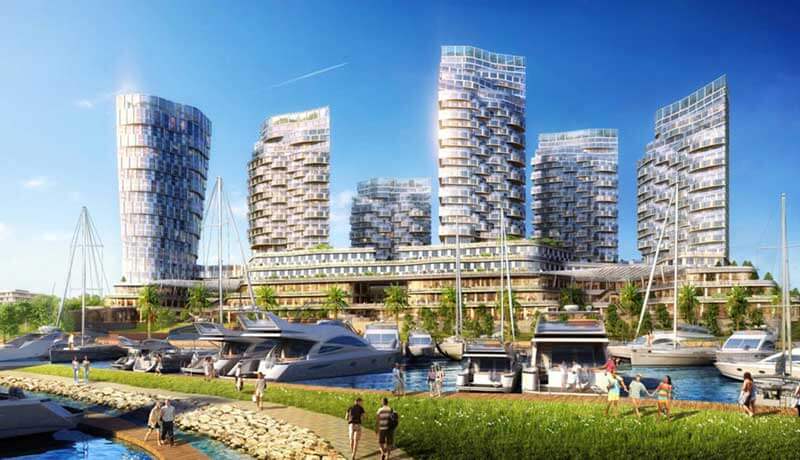- China’s ‘treescrapers’ tackle air pollution
- Bogota’s blossom garden: next-level purifiers
- Urban jungles – why do we need them?
- London’s Garden Bridge is like a forest across the Thames
- Vietnam’s Forest in the Sky – tropical jungle in the middle of Hanoi
- Honeycomb building in the heart of Istanbul
- Architecture meets nature
Modern life often leaves us stressed and in need of peace and quiet. And what better way to get a dose of that that than spending time in nature? Being surrounded by greenery reduces tension and helps us relax. But not all of us are lucky enough to live close to the mountains or visit a forest every weekend. However, urban city planners might have a solution.
Integrating urban forests into architecture leads to breathtaking results. Sometimes referred to as treescrapers, these buildings have plenty to offer beyond their unique architecture. Implementing sustainable principles, they are a breath of fresh air in high density cities — literally. Urban forests provide us with better air quality by increasing the available oxygen. Also, they ensure a safe habitat for animals that in most cases wouldn’t survive the harsh conditions of crowded cities.
The idea of urban forests is not as new as you might think. Architects have embraced the trend of turning roofs into pleasant gardens for years. Today, though, installing greenery is no longer focused only on rooftops. The sides of buildings are becoming vertical gardens, but accomplishing this can be rather challenging. Designers must reinforce buildings to support the weight of trees, which can be expensive. Then there’s the additional costs of maintaining the vegetation. Still, the resultant relaxing, healthy environment is more than worth it. These green buildings are no longer part of the future – they are already sprouting up all over the world.
Free trendservice
China’s ‘treescrapers’ to tackle air pollution
China suffers from severe outdoor air pollution. Maria Neria, director of the WHO’s public health and environment department, told The Guardian that the data on air quality was alarming. “What we are learning is, this is very bad. Now there are no excuses for not taking action.” China has decided to fight air pollution with ‘green architecture,’ joining forces with Stefano Boeri, the Italian architect who gained attention with Milan’s Bosco Verticale (Vertical Forest). The Chinese vertical forest – and Boeri’s first in Asia – is a complex consisting of two neighbouring towers, covered with over twenty species of trees and a couple of thousand shrubs that will help Nanjing breathe again.
The smaller of the towers will house a luxurious hotel, while the taller is set to provide space for a museum, a rooftop club, and even a green architecture school for sustainable design. And what’s more, these green buildings will act as the city’s lungs, ‘inhaling’ up to 25 tonnes of carbon dioxide, and ‘breathing out’ almost 60 kg of oxygen every day. There’s no doubt that the concept of ‘vertical forests’ will help combat low air quality.

Bogota’s blossom garden: next-level purifiers
With 3100 square metres of greenery covering the eleven-storey building, Edificio Santalaia is the largest vertical garden in the world. Completed in 2015, it’s the result of a collaboration between the Spanish design firm, Paisajismo Urbano, and a Colombian company named Groncol. The vertical garden consists of over ten plant species from five different, yet compatible, families. “The selection of the species is fundamental in this type of gardens, since the biodiversity in a vertical ecosystem allows the interaction between the species that form it, both plants and microorganisms,” explained Ignacio Solano, the head of Paisajismo Urbano.
A patented system of forty irrigation sectors is designed to provide adequate water for the greenery. This unique irrigation system recycles the wastewater as well as the leftover water streaming through the walls of the garden. And the garden doesn’t only contribute to the aesthetics of the city – it is “capable of producing the oxygen needed by more than 3,100 people a year, processing about 775 kilograms of heavy metals, filtering more than 2,000 tons of harmful gases and catching more than 400 kilograms of dust.” Moreover, the blanket of selected plants provides isolation for the building, ensuring the pleasant temperature inside the building during warm summer days, which reduces the need for air conditioning.
Urban jungles – why do we need them?
By 2050, more than 70% of people will live in urban areas, and Simone Borelli, co-author of a recent FAO report on global urban forestry guidelines, recently shared his concerns with CNN. “The cities of the future are going to have major problems in making sure that people live a decent life.” Avenues of tall, lavish trees and parks play a significant role in maintaining quality of life in a city, protecting it from extreme weather induced by global warming and capturing dangerous rainwater in heavy storms. Sometimes, the threats they protect us from are surprising.
For instance, Stephen Sheppard, a professor in urban forestry at the University of British Columbia (UBC) in Vancouver, Canada, told CNN that, “In Vancouver a few years ago, we had a million people without drinking water for almost a month because they had so much heavy rain and it whipped up the mud and the sediment in the reservoirs and it wasn’t safe to drink.” Urban forests can provide solutions to these problems by absorbing excess water caused by heavy rain. This can help reduce soil erosion and protect drinking water.
London’s Garden Bridge is like a forest across the Thames
Not only buildings are becoming green. In fact, London might have its first green bridge. The Garden Bridge over the Thames was initially designed as a memorial to Princess Diana, but now, a variety of trees and plants will find a home on the bridge as well. The architecture of the bridge will be divided into sections, and each will be a habitat for different plant and tree species. The idea behind the Garden Bridge concept is to encourage people to lead a healthier lifestyle by walking more. And while they walk across the Garden Bridge, they can stop and admire the beauty of nature.

Vietnam’s Forest in the Sky – tropical jungle in the middle of Hanoi
Often, architecture doesn’t blend well with nature. But that’s not the case with Vietnam’s Forest in the Sky building complex. It was developed by the Flamingo Dai Lai Stock Company and envisioned as an integral part of Hanoi’s green environment. This highly sustainable building was awarded with a certificate given to buildings that reduce energy use by a minimum of 20%. Forest in the Sky will surpass that with an estimated 29% energy reduction through implementing energy-saving light bulbs and hot water boilers. But this building offers more than high sustainability. Its visual appeal will be enhanced by planting more than 50,000 different trees and flowers on the building’s facade, turning it into a tropical jungle. Walls made from eco-friendly materials will provide residents with insulation from heat and sound, enabling them to relax whenever they want.

Honeycomb building in the heart of Istanbul
Urban Rural is a concept developed by the architecture and design studio, Eray Carbayo. It’s based on using rural construction elements in an urban environment. Designers at Eray Carbayo created a building inspired by traditional elements of rural homes and gardens. By the time it’s completed in 2019, this eight-storey building will be a hexagonal structure resembling honeycombs. This particular shape enables designers to maximise the building size while reducing the amount of building materials needed. Each hexagon is a single unit filled with plants and trees, similar to a rural garden. Also, the rooftop will provide residents with additional space to grow their own food. Thanks to the water collection system, the building will save up to 53% of its water, and it will reduce energy usage by 15%. Since it’s located in the centre of Istanbul, in close proximity to major city services, it will entice residents to live healthier lives by walking and cycling instead of using their cars.

Architecture meets nature
Today’s crowded cities demand sustainable architectural solutions. The city of the future helps architecture meet nature, providing the best of both worlds. Vertical forests and gardens will ensure clean air, while urban jungles will help residents relax and recharge.
Share via:


